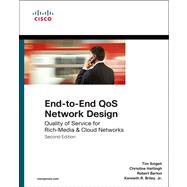End-to-End QoS Network Design
Quality of Service for Rich-Media & Cloud Networks Second Edition
New best practices, technical strategies, and proven designs for maximizing QoS in complex networks
This authoritative guide to deploying, managing, and optimizing QoS with Cisco technologies has been thoroughly revamped to reflect the newest applications, best practices, hardware, software, and tools for modern networks.
This new edition focuses on complex traffic mixes with increased usage of mobile devices, wireless network access, advanced communications, and video. It reflects the growing heterogeneity of video traffic, including passive streaming video, interactive video, and immersive videoconferences. It also addresses shifting bandwidth constraints and congestion points; improved hardware, software, and tools; and emerging QoS applications in network security.
The authors first introduce QoS technologies in high-to-mid-level technical detail, including protocols, tools, and relevant standards. They examine new QoS demands and requirements, identify reasons to reevaluate current QoS designs, and present new strategic design recommendations. Next, drawing on extensive experience, they offer deep technical detail on campus wired and wireless QoS design; next-generation wiring closets; QoS design for data centers, Internet edge, WAN edge, and branches; QoS for IPsec VPNs, and more.
Tim Szigeti, CCIE No. 9794 is a Senior Technical Leader in the Cisco System Design Unit. He has specialized in QoS for the past 15 years and authored Cisco TelePresence Fundamentals.
Robert Barton, CCIE No. 6660 (R&S and Security), CCDE No. 2013::6 is a Senior Systems Engineer in the Cisco Canada Public Sector Operation. A registered Professional Engineer (P. Eng), he has 15 years of IT experience and is primarily focused on wireless and security architectures.
Christina Hattingh spent 13 years as Senior Member of Technical Staff in Unified Communications (UC) in Cisco’s Services Routing Technology Group (SRTG). There, she spoke at Cisco conferences, trained sales staff and partners, authored books, and advised customers.
Kenneth Briley, Jr., CCIE No. 9754, is a Technical Lead in the Cisco Network Operating Systems Technology Group. With more than a decade of QoS design/implementation experience, he is currently focused on converging wired and wireless QoS.
n Master a proven, step-by-step best-practice approach to successful QoS deployment
n Implement Cisco-validated designs related to new and emerging applications
n Apply best practices for classification, marking, policing, shaping, markdown, and congestion management/avoidance
n Leverage the new Cisco Application Visibility and Control feature-set to perform deep-packet inspection to recognize more than 1000 different applications
n Use Medianet architecture elements specific to QoS configuration, monitoring, and control
n Optimize QoS in rich-media campus networks using the Cisco Catalyst 3750, Catalyst 4500, and Catalyst 6500
n Design wireless networks to support voice and video using a Cisco centralized or converged access WLAN
n Achieve zero packet loss in GE/10GE/40GE/100GE data center networks
n Implement QoS virtual access data center designs with the Cisco Nexus 1000V
n Optimize QoS at the enterprise customer edge
n Achieve extraordinary levels of QoS in service provider edge networks
n Utilize new industry standards and QoS technologies, including IETF RFC 4594, IEEE 802.1Q-2005, HQF, and NBAR2
This book is part of the Networking Technology Series from Cisco Press®, which offers networking professionals valuable information for constructing efficient networks, understanding new technologies, and building successful careers.









